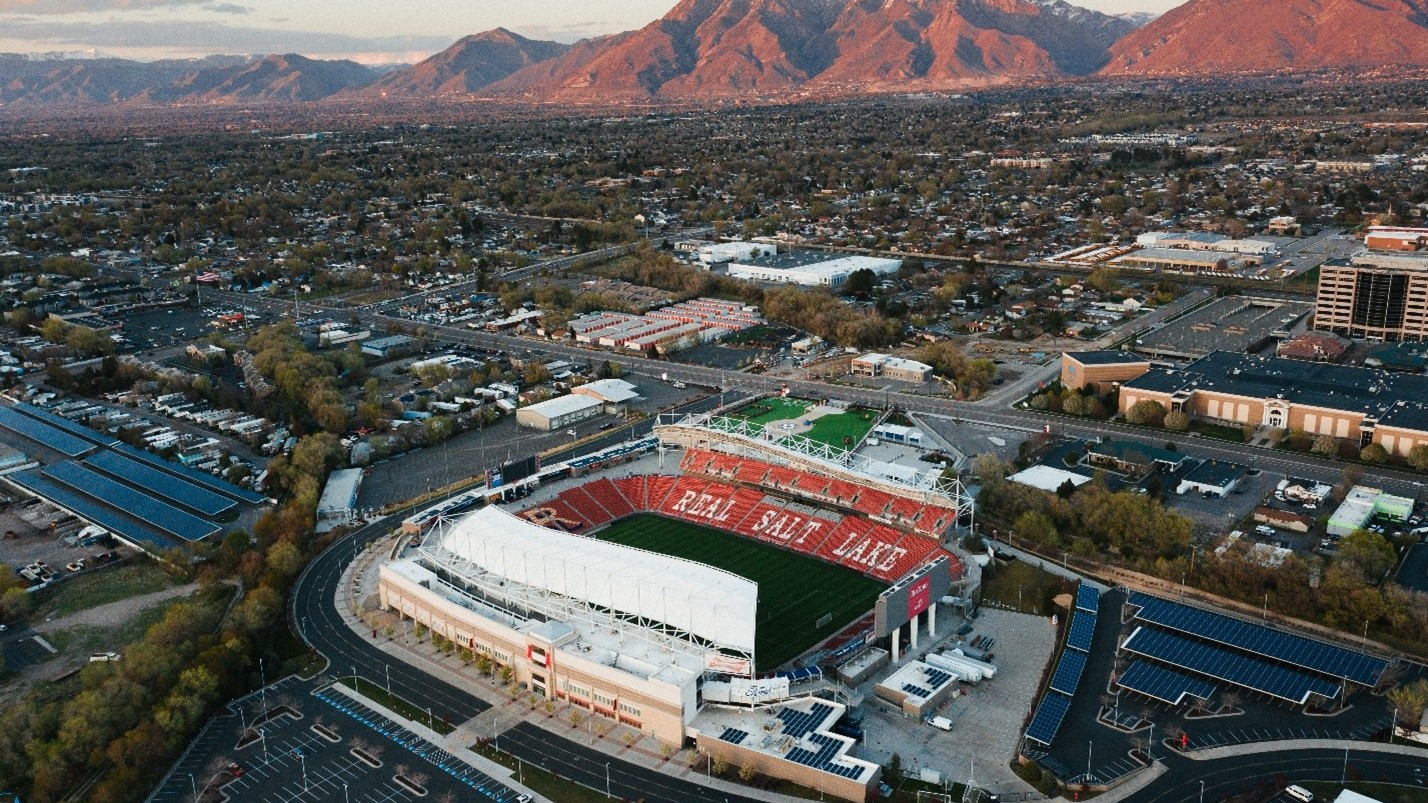Solar in Sports: Major League Sports Venues Across America Tap into Renewable Energy

Millions around the country will gather in front of their screens this weekend to witness the biggest football game of the year, but they may not realize that the Kansas City and Philadelphia teams have solar powered stadiums. While this may be a historic Super Bowl with two Black quarterbacks starting in the big game, it’s the fifth time that both Super Bowl contenders have home stadiums that are powered by the sun.
The solar powered soccer stadium at America First Field where Real Salt Lake play. Photo courtesy of Real Salt Lake.
Millions around the country will gather in front of their screens this weekend to witness the biggest football game of the year, but they may not realize that the Kansas City and Philadelphia teams have solar powered stadiums. While this may be a historic Super Bowl with two Black quarterbacks starting in the big game, it’s the fifth time that both Super Bowl contenders have home stadiums that are powered by the sun.
Last year, more than 40 million Americans attended a solar-powered sporting event, according to new analysis from the Solar Energy Industries Association (SEIA). The research shows that the NFL may have the highest percentage of stadiums with solar at 32%, but MLB and the NBA don’t trail far behind, tying at 30%. Sports arenas and stadiums are massive venues that typically host more than 65,000 spectators per game, which can result in up to 10 megawatts (MW) of electricity used every game. To put that into perspective, 10 MW of solar electricity is enough to power more than 1,700 homes.
An incredible amount of energy is needed every year to power our favorite pastimes, but on- and off-site solar panels can help sports teams save money on their electricity bills and curb emissions. Today, 47 major league teams in America now have solar, which is about one-third of all of the teams SEIA tracked, pointing to the growing trend of teams, venues, and corporations looking to invest in clean energy. As the clean energy revolution takes hold, it’s likely even more teams will join them over the next decade.
Let’s take a look at the five largest solar installations at arenas and stadiums across the country. Hint: one of this year’s Super Bowl contenders appears in the top 5.
FedEx Field
Location: Landover, MD
Teams: NFL’s Washington Commanders
System size: 2 MW
Current ranking: 5th
FedEx Field sits just outside our nation’s capital and is home to the three-time Super Bowl champion the Washington Commanders. The team installed more than 8,000 solar panels in 2011, making it one of the largest solar installations in the Washington, DC metropolitan area. The system generates enough electricity to meet 20% of the stadium’s power on gamedays and can meet all of its power demands on non-game days.
America First Field
Location: Sandy, UT
Teams: MLS’ Real Salt Lake
System size: 2 MW
Current ranking: 4th
America First Field is home to Major League Soccer’s Real Salt Lake and also hosted the National Women’s Soccer League’s Utah Royals before they transferred to Kansas City. With 6,423 panels covering its parking structures and the venue itself, America First Field can generate over 2 megawatts of electricity, offsetting 73% of its total energy consumption. The arrays are the largest solar powered system in Major League Soccer.
Capital One Arena
Location: Washington, DC
Teams: NHL’s Washington Capitals, NBA’s Washington Wizards
System size: 3.5 MW
Current ranking: 3rd
Another representative from the Washington, DC area, Capital One Arena purchases 3.5 MW of solar electricity from an off-site facility in Maryland, making the Washington Capitals the top solar user in the NHL and the Washington Wizards the number two solar user in the NBA. The 3.5 MW of solar capacity delivered to Capital One Arena is the second largest off-site solar energy contract used to power a professional sports facility.
Lincoln Financial Field
Location: Philadelphia, PA
Teams: NFL’s Philadelphia Eagles
System size: 4 MW
Current Ranking: 2nd
“The Linc,” home to one half of the 2023 Super Bowl lineup, installed 11,000 solar panels in 2013. The 4 MW system is not only the largest solar power project in Philadelphia, but also the largest one in the NFL. The system covers about one-third of the stadium’s energy needs annually, which is more than enough to power the team’s home games for a year. In addition, it’s projected that the panels could save the team around $60 million over the next two decades. The Eagles maintain a live solar generation tracker for its solar panels and have a longstanding commitment to sustainability.
Golden 1 Center
Location: Sacramento, CA
Teams: NBA’s Sacramento Kings
System size: 8.6 MW
Current ranking: 1st
It may not come as a surprise that the largest solar portfolio among the major U.S. professional sports teams is in the largest solar market in the country — California. The Golden 1 Center uses a mix of on-site and off-site solar capacity totaling 8.6 MW, which accounts for 24% of all the capacity tracked in SEIA’s Solar in Sports report and 58% of the solar capacity installed at NBA arenas. This large system generates more electricity than all the solar capacity installed at MLB, NHL and WNBA facilities combined, and is the world’s first arena to be 100% solar powered, 365 days a year.
Sports venues seem to be big fans of solar, and with the benefits that come along with it, we can’t blame them. The next time you tune into a professional sports event, take note of which teams are making the commitment to a clean energy future. Their influence can make all the difference.
To learn more about the professional sports teams that are going solar, download Solar in Sports: A Study on Solar in U.S. Professional Sports.

